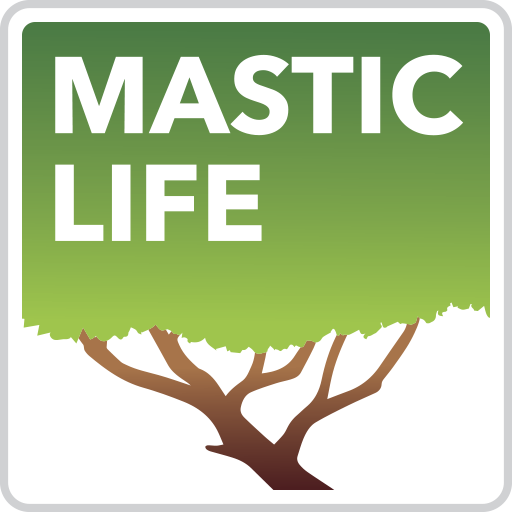Studies: CHIOS MASTIC AND ORAL HEALTH
In accordance with Herodotus (484–425 BC), Chios Mastic had been beneficial to oral cavity hygiene. In De Materia Medica, Dioscorides (40–90 AD) mentions that Chios Mastic is useful for cleaning the teeth and for odouring the mouth when chewed. Other relevant citations have been made during the Ottoman period and they last till our times. Undoubtedly, Chios Mastic is essential for oral hygiene due to its antimicrobial action against many oral bacterial species. Countless trials have indicated the strong relationship of Chios Mastic with antiplaque effects, chronic periodontitis, prevention of caries, periodontal disorders, treatment of oral malodor and gum disease, and other oral cavity conditions.
Study 1
Watanabe et al (1973) performed a double blind randomized control trial evaluating Chios Mastic oil dentifrice on chronic periodontitis using a sonic toothbrush. 22 volunteers were divided into two groups: experimental (Chios Mastic dentifrice) and placebo. Clinical and microbiological parameters were measured at baseline, 2, 4, and 12 weeks. Chios Mastic group showed significant reduction in inflammation, gingival swelling, bleeding, redness, and plaque accumulation compared to placebo. Notably, suppression of Porphyromonas gingivalis and other pathogens was observed, suggesting beneficial effects in chronic periodontitis treatment.
Study 2
Topitsoglou et al (1985–86) showed that systematic use of Chios Mastic chewing gum significantly reduced dental plaque in 10 volunteers. One group chewed Chios Mastic gum for 10 days, while the other chewed placebo gum. The Chios Mastic group had a notable decrease in microbial plaque, supporting its use in caries prevention and periodontal health.
Study 3
Farella et al (2001) studied effects of prolonged chewing of hard gum (Chios Mastic) on jaw muscles. 15 women chewed hard gum, soft gum, or performed empty chewing. Pain and fatigue increased only during hard gum chewing but returned to baseline within 10 minutes post-chewing, indicating rapid recovery of masticatory muscles without temporomandibular disorders.
Study 4
A comparison of 6 commercial gums, including Chios Mastic, assessed rheological properties and chewing response in elderly and younger adults. Natural Chios Mastic differed in fluidity and viscosity from synthetic gums, influencing chewing modulation across age groups.
Study 5
A 2003 Japanese study on 20 dental students showed that chewing Chios Mastic gum reduced bacterial colonies in saliva compared to placebo and lowered plaque and gingival indices over 7 days without mechanical oral hygiene, confirming its antiplaque effects.
Study 6
In 2006, a Turkish study demonstrated significant antibacterial effects of Chios Mastic against Streptococcus mutans in 25 healthy individuals, showing potential to prevent caries.
Study 7
Sterer (2006) found that methanolic extracts of Chios Mastic inhibited Porphyromonas gingivalis, suggesting potential for treating gum disease and oral malodor.
Study 8
Aksoy et al (2007) studied Chios Mastic’s antibacterial activity against oral bacteria in orthodontic patients. Chewing the gum significantly reduced S. mutans, lactobacilli, and total bacteria compared to placebo, supporting caries prevention.
Study 9
In 2009, a study comparing Chios Mastic and xylitol chewing gums found both enhanced remineralization of caries-like lesions similarly.
Study 10
A 2009 study evaluated biological actions of Chios Mastic, showing selective antibacterial effects against key oral pathogens and cytotoxic effects on leukemic cells, supporting its oral health benefits.
Study 11
Al Mofarji et al (2013) demonstrated that chewing Chios Mastic for 45 minutes significantly decreased total oral bacterial counts, including staphylococci, Neisseria, and oral streptococci.
Study 12
Biria et al (2014) assessed three gums over 3 weeks, finding all reduced Mutans streptococci counts, with mixed effects on lactobacilli and saliva pH, confirming Chios Mastic’s antiplaque properties.
Study 13
Lee et al (2014) found that Chios Mastic protects human keratinocytes from oxidative stress by reducing apoptosis and promoting autophagy, evidencing antioxidant activity.
Study 14
Karygianni et al (2014) showed that Chios Mastic extracts exhibited strong antimicrobial effects against oral bacteria, especially Gram-negative anaerobes, suggesting use against periodontitis.
Study 15
Makaremi et al (2016) found that chewing Chios Mastic improved stability in orthodontic molar expansion, aiding balanced occlusal function and dentofacial development.
Study 16
Koychev et al (2017) compared Chios Mastic extract with hydrogen peroxide and chlorhexidine, showing superior inhibition of periodontal pathogens and lower cytotoxicity, supporting its use as a safe natural antibacterial agent for periodontal disease prevention.
Note: Chios Mastic is a natural dietary supplement with beneficial effects on oral health. It is not a medicine and should not replace professional dental care.
Chios Mastic Gum – Benefits for Oral Health
- Historical use: Herodotus and Dioscorides mention Chios Mastic for teeth cleaning and freshening breath.
- Antimicrobial effects: Effective against oral bacteria including Porphyromonas gingivalis, Streptococcus mutans, lactobacilli, and total oral bacteria.
- Antiplaque & periodontal support: Reduces dental plaque, inflammation, gingival bleeding, and supports prevention of caries and periodontitis.
- Chewing effects: Improves jaw muscle activity and stability during chewing, without causing temporomandibular disorders.
- Antioxidant activity: Protects human keratinocytes from oxidative stress, reduces apoptosis, promotes autophagy.
- Comparisons: Chios Mastic gum shows superior natural properties vs synthetic gums, xylitol, or chemical agents like hydrogen peroxide.
- Clinical studies: Multiple double-blind, placebo-controlled, and in vivo studies (1973–2017) confirm antiplaque, antibacterial, and oral health benefits.
- Conclusion: Chios Mastic is a natural dietary supplement that supports oral hygiene, gum health, and reduces bacterial load; it is not a medicine and does not replace professional dental care.
- Watanabe H., Hagiwara S., Fukuda M., Yuichi I., Tamura N., Suzuki M., Kawasaki D., Fukahori M. [1973]: Double blind randomized control test for the usefulness of mastic compound dentifrice against periodontitis under using sonic toothbrush journal title. Yakuri To Chiryo, 38 (10): 915-925.
- Topitsoglou-Themeli V., Dangalis P., Lambrou D. [1984]: Chios Mastic and oral hygiene I: A possible measure for decrease microbial plaque formation. Hell. Stom. Chron., 28: 166-170.
- Topitsoglou-Themeli V., Kolokotronis A., Dangalis P., Lambrou D. [1985]: Chios Mastic and oral hygiene II: Differentiation in microbial plaque formation. Redodontia., 2: 56-59.
- Farella M., Bakke M., Michelotti A., Martina R. [2001]: Effects of prolonged gum chewing on pain and fatigue in human jaw muscles. Eur. J. Oral Sci., 109 (2): 81-85.
- Anastassiadou V., Siovas S. [2002]: Modulation of chewing rhythms to changes in viscoelasticity of chewing gums in people with different age and dental status. Stomatologia, 59 (1): 39-49.
- Takahashi K., Fukazawa M., Motohira H., Ochiai K., Nishikawa H., Miyata T. [2003]: A pilot study on antiplaque effects of mastic chewing gum in the oral cavity. J. Periodontol., 74 (4): 501-505.
- Aksoy A., Duran N., Koksal F. [2006]: In vitro and in vivo antimicrobial effects of mastic chewing gum against Streptococcus mutans and mutans streptococci. Arch. Oral Biol., 51 (6): 476-481.
- Sterer N. [2006]: Antimicrobial effect of mastic gum methanolic extract against Porphyromonas gingivalis. J. Med. Food, 9 (2): 290–292.
- Aksoy A., Duran N., Toroglu S., Koksal F. [2007]: Short-term effect of mastic gum on salivary concentrations of cariogenic bacteria in orthodontic patients. Angle Orthod., 77 (1):124-128.
- Biria M., Malekafzali B., Kamel V. [2009]: Comparison of the effect of xylitol gum- and mastic chewing on the remineralization rate of caries-like lesions. J. Dentistry, 6 (1): 6-10.
- Sakagami H., Kishino K., Kobayashi M., Hashimoto K., Iida S., Shimetani A., Nakamura Y., Takahashi K., Ikarashi T., Fukamachi H., Satoh K., Nakashima H., Shimizu T., Takeda K., Watanabe S., Nakamura W. [2009]: Selective antibacterial and apoptosis-modulating activities of mastic. In vivo, 23: 215-224.
- Al-Mofarji T., Al-Zahid N.R., Al-Hashimy E.H. [2013]: Antibacterial effect of mastic gum on aerobic oral bacteria. Iraqi Nat. J. Nurs. Spec., 26 (2): 136-140.
- Biria M., Eslami G., Taghipour E., Akbarzadeh Baghban A. [2014]: Effects of three mastic gums on the number of mutans streptococci, lactobacilli and pH of the saliva. J. Dent., 11 (6): 672-679.
- Lee B.Y., Lee K.H., Kim I.R., Kim Y.H., Park H.R., Park B.S. [2014]: The inhibition of oxidative stress by Chios gum mastic is associated with autophagy. Int. J. Oral Biol., 39 (2): 65-73.
- Karygianni L, Cecere M, Skaltsounis AL, Argyropoulou A, Hellwig E, Aligiannis N, Wittmer A, Al-Ahmad A. [2014]: High-level antimicrobial efficacy of representative Mediterranean natural plant extracts against oral microorganisms. Biomed Res Int., 839019
- Makaremi M, Zink K, de Brondeau F. [2016]: The importance of elevated masticatory forces on the stability of maxillary expansion. J Dentofacial Anom Orthod.,
- Koychev S, Dommisch H, Chen H, Pischon N. [2017]: Antimicrobial Effects of Mastic Extract Against Oral and Periodontal Pathogens. J Periodontol., 88: 511-517.
Mastic for your gastrointestinal tract
-
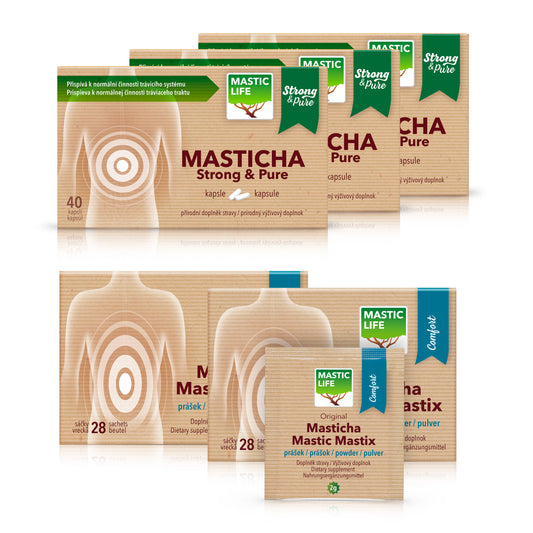 8-week treatment 🗓️
8-week treatment 🗓️Mastic 8 weeks
Regular price £70.00 GBPRegular price£88.00 GBPSale price £70.00 GBPSale -
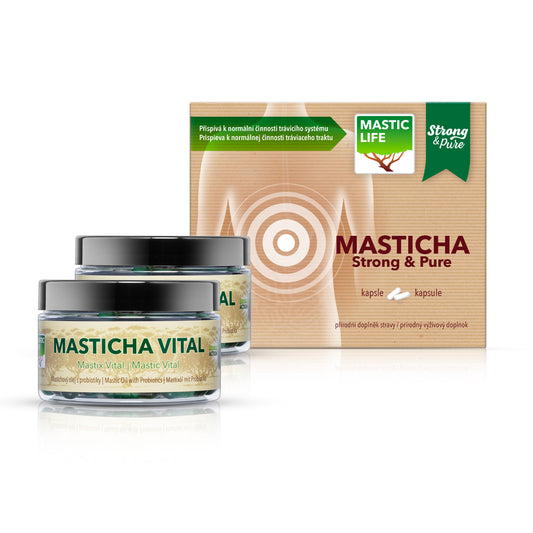 60-day treatment 💪
60-day treatment 💪Mastic Gum Extra for 60 days
Regular price £125.00 GBPRegular price£157.00 GBPSale price £125.00 GBPSale -
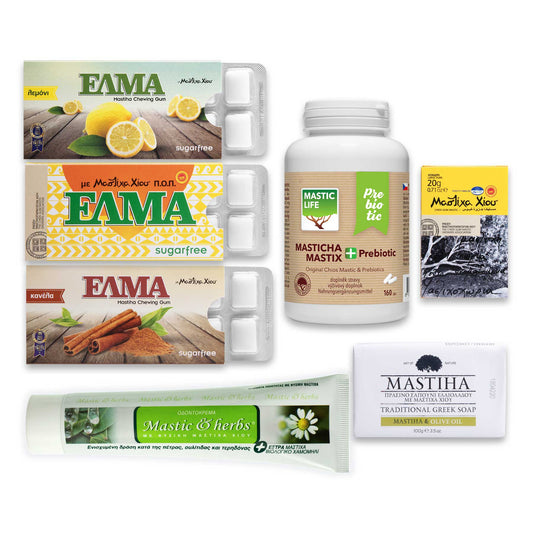 Gift set 🎁
Gift set 🎁Mastic „Life with Mastic"
Regular price £53.00 GBPRegular price£57.00 GBPSale price £53.00 GBPSold out -
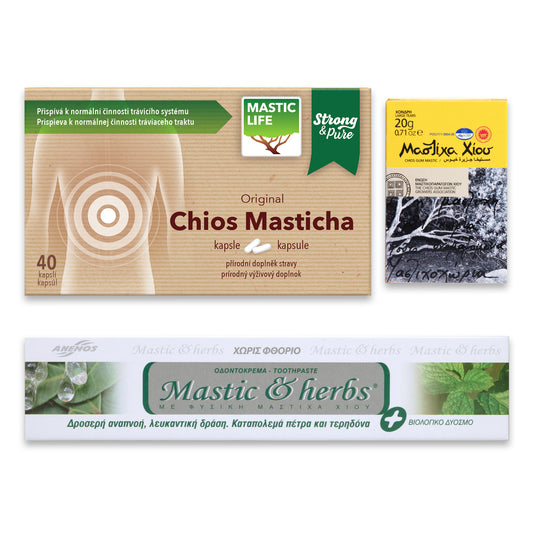 Gift set 🌿
Gift set 🌿Mastic „Pure Mastic“
Regular price £27.00 GBPRegular price£30.00 GBPSale price £27.00 GBPSale
